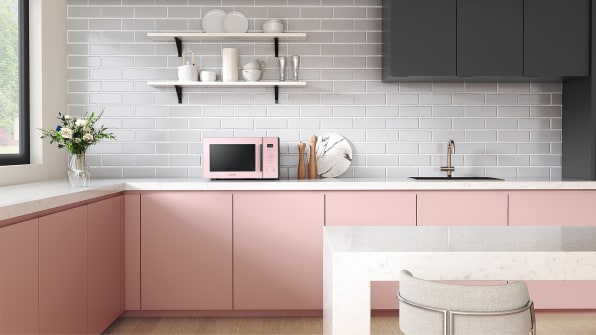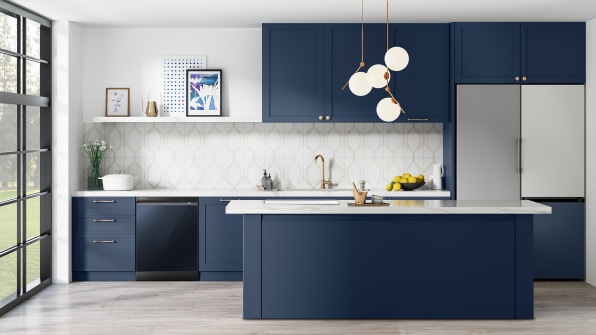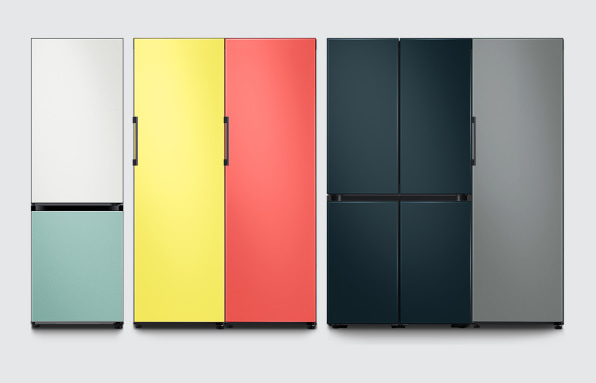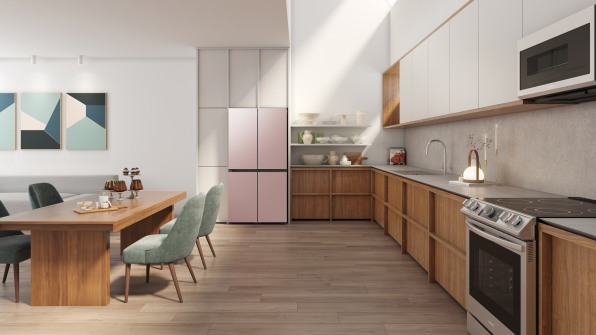The refrigerator of today is a wall of gleaming steel, sparkling like a robot from some 1950s sci-fi TV show. But Samsung has a different vision for the future of your kitchen. Samsung imagines your fridge as a blocky, Piet Mondrian painting. You can choose the size and shape, and even the color, to perfectly match your walls. And this customization won’t just be applied to your fridge. All of your appliances, from your dishwasher to your air purifiers, will soon be elevated to furniture status.


For a company such as Samsung, which has spent the last decade sticking (sometimes parodied) touchscreen computers into its highest-end fridges, Bespoke is a completely different vision for the future. Harry Choi, SVP and head of the design team for Samsung’s digital appliances business, promises that those touchscreen fridges aren’t going anywhere. But he does admit that Samsung has bifurcated its strategy after analyzing the last 100 years of the American kitchen.

Baby boomers loved the side-by-side. Then, in the late 1990s, manufacturers introduced something new, the French door refrigerator. Now, the top of the fridge opened with two doors, while the bottom pull-out drawer was dedicated to the freezer. Meanwhile, stainless steel became all the rage as a premium finish inspired by the design of commercial kitchens. And fridges kept getting bigger, Choi explains, in an arm’s race for the largest storage capacity possible.
But looking forward, Choi and his team wondered, what kind of refrigerator do millennials want?
“In Korea, people use the word ‘adopt’ when we talk about buying furniture, but when they talk about appliances, they use ‘purchase,'” says Choi. Samsung wanted to make a refrigerator that was worth adopting.
Looking at trends in urban living—that many young people are moving into smaller, often urban spaces—Samsung knew capacity wasn’t the goal. Furthermore, shopping habits are changing. The single, weekly grocery store stock-up has been offset with delivery services and meal kits. That meant Samsung could focus on building a fridge that was flat-fronted, meant to blend more with its environment, rather than swelling out to take up every possible inch of storage space. Perhaps that smaller approach isn’t completely in line with the toilet-paper-hoarding mentality of COVID-19, but it does seem to be on the pulse of general consumer shopping trends.

And in turn, Samsung is doubling down with its approach. In Korea, Samsung has already launched Bespoke dishwashers, induction ranges, and microwaves to match the refrigerators, and Choi says we should expect Samsung to bring more appliances into the fold moving forward—even including vacuum cleaners.
As of today, Bespoke products are available in a handful of colors. But Choi shares that Samsung is working on a partnership with Benjamin Moore Korea to bring its line of all 4,000 paint colors to Bespoke products. Smeg has sold refrigerators in many colors for decades, while brands such as KitchenAid have treated standing mixers as statement pieces to give a pop of color to an otherwise neutral kitchen. But with such an unprecedented partnership, you could literally paint your home to match or complement appliances perfectly, further blurring the lines between kitchens, laundry rooms, and general living spaces.
Still, color matching is “simply the first step” for Bespoke, Choi insists. Ultimately, it’s the modularity of these digital appliances—and the potential to stack, squeeze, and customize such large-scale machinery into the fabric of your home—that Samsung is excited about. I mention to Choi that the future of Bespoke sounds a lot like Vitsœ customizable shelving. The famous shelving brand designed by Dieter Rams lets you customize storage to perfectly fit your space. It seems Samsung is taking a similar approach to tailor kitchens to one’s home, no matter the small apartment footprint. Choi agrees.
“For me, making appliances that are beloved by users and enhance quality of life of users is an important life philosophy,” says Choi. “Although [Bespoke] is a small attempt, I think this is really a thing.”
January 06, 2021 at 06:00PM
https://ift.tt/2LsLJ01
Sorry, stainless steel. Samsung has a flashier vision for your kitchen - Fast Company
https://ift.tt/31VSHRH
Samsung
No comments:
Post a Comment